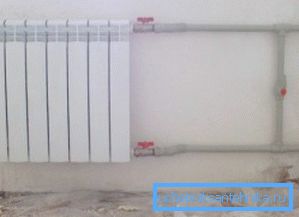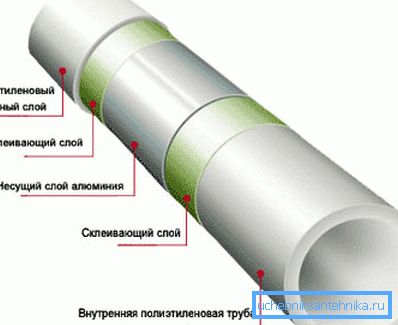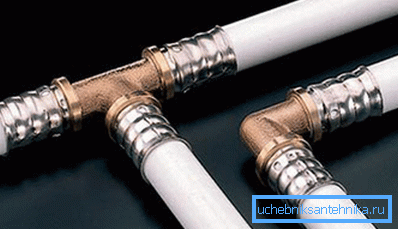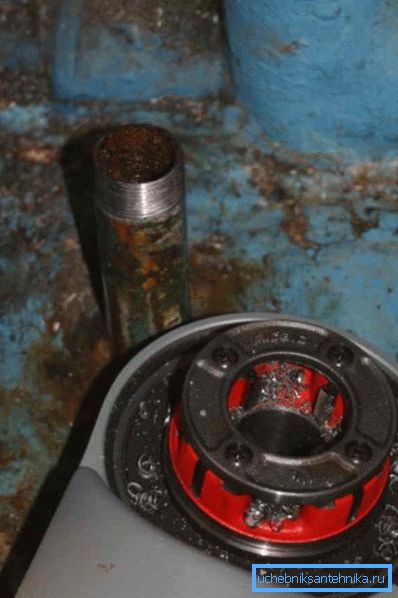Replacing the heating pipes in the apartment - the main
In order not to figure out who is to blame if the heating pipe in the apartment broke, it is best to perform maintenance and replace the communication networks in time. The fact is that in steel pipes, which are installed in all high-rise buildings, plaque forms over time, which significantly reduces throughput and impairs heat transfer. In addition, the metal is destroyed by corrosion, and over time the pipes can simply rust.
It is better not to wait for emergency situations and replace the pipelines in the current order, this will not only increase reliability, but also improve the heat transfer of the entire system.

Basic system parameters
In order to determine which pipes to use when replacing, it is necessary to understand the conditions in which communications work and what influences they are exposed to during operation. It is important that the option you choose matches the following parameters:
| Pressure readings | One of the most important values, which is often the cause of faults and leaks. If all operating conditions are met, this indicator ranges from 3.5 to 5 kgf per cm2. But it is worth remembering that sometimes the system is subjected to short-term pressure surges, which can range from 12 to 25 kgf per cm2 (with a sharp opening of the valves during filling and in other similar cases). |
| Temperature values | The norms of SNiP determined that the temperature of the coolant in the system should not be more than 95 degrees. Practically all materials intended for use in heating communications withstand such loads, but sometimes (when servicing the elevator nozzle at which it is removed) the temperature of the heating pipes in an apartment can even reach 140 degrees. |
| Strength indicators | Not all materials with high resistance to temperature effects and excessive pressure are able to withstand the deformation that occurs during shocks and other effects (for example, when there are children in the house, they can hang on pipes, walk on them, and so on). |
| Life time | Some options have a short lifespan, which can be even less with various adverse effects. Since the replacement work is rather laborious and expensive, it is better not to save on materials and choose those products that are guaranteed to last at least a decade. |

Pipe making material
To ensure the strength and efficiency of the design, it is necessary to carry out all work with the highest quality, while the materials used must meet a variety of standards. To begin, consider the most common and popular options.
Steel products
There are a lot of different options on the market, but due to the fact that the temperature and pressure in the heating pipes in an apartment building can significantly exceed the stated figures, some of the options can be initially excluded. For example, the same cross-linked polyethylene is not able to withstand more than 100 degrees, therefore, it is strongly recommended not to use it.

Steel pipes are always popular due to the fact that the price is quite democratic, and they are able to withstand even very high loads.
The following factors can be distinguished from features:
- The material is susceptible to corrosion, and over time a raid may form on the inner walls, which deteriorate the heat transfer of surfaces, and in the most difficult situations this can lead to the formation of plaque.
- It is impossible to carry out work with your own hands without welding equipment and metal-cutting tools. Welding requires certain skills and is not recommended without proper qualifications.

- To maintain an attractive appearance, pipelines must be painted periodically (do not forget that the system is constantly heating up, so you should use compounds that are resistant to high temperatures).
Galvanized pipes
This option has all the advantages of steel products, but at the same time is devoid of many of the disadvantages of conventional metal, judge for yourself:
- A layer of zinc is coated on the outside as well as on the inside. Due to this, the products become much more resistant to corrosion and the formation of plaque inside the pipes. Of course, the cost is different, but the difference is not so fundamental.

- Works on installation of the system are no different from the installation of conventional steel pipes. But it is worth remembering one very important factor: when welding metal emit harmful compounds, therefore, work without protective equipment is strictly prohibited, and the room in which the installation takes place should be well ventilated.
Note! Providing high performance properties is possible only when using high-quality galvanization. Unfortunately, there are a large number of low-quality products on the market, which are quite simple to distinguish: the coating will be uneven, with stains and spots, without a characteristic luster.
Metal plastic
When considering which pipes it is better to use for heating an apartment, one cannot fail to touch on the widely popular PVC products with a reinforcing layer, which can be either a thin aluminum layer or a more durable mesh, which acts as a kind of frame that guarantees the stability of the structure even in the most adverse conditions.

The main features of this option are:
- The small weight of products facilitating their loading and transportation. Due to its low mass, installation is greatly simplified.
- Non-susceptibility of pipes to corrosion, as the metal part of the structure is reliably protected by a layer of plastic, this is the reason for the long life of such systems.

- A simple installation process, assembly instructions for the system is quite simple, and for the work you will need a key to clamp the threaded connections of the metal-plastic pipes, and if press fittings are used, then even it is not needed.
Note! When using press fittings, it is very important that the pipes are cut perfectly and the ends are treated, as any burrs and tears can damage the sealing ring and cause a leakage hazard.
- If in the future it may be necessary to completely or partially disassemble the system, it is better to use press fittings or collet fasteners. Since they can be removed and reused, saving significant funds.
Workflow features
Replacing and repairing heating utilities in an apartment is in many ways different from work in private houses and separate buildings, so you should consider in detail the order of work:

- First of all, it is necessary to coordinate repair works with public utilities., as in order to dismantle old elements, it is necessary to discharge and drain the risers, most often this is done by a plumber serving your house.
- Next turns one of the radiator nipples, this will get rid of the remaining fluid in the system.
- The ideal solution is to replace the entire heating riser, but if the neighbors did not agree, then the work is carried out as follows: a part of the pipe is cut off, after which the thread is cut from both sides, For this purpose, a die for pipes of the appropriate size is used.
- Further work depends on the type of pipe used.. When using metal products can be used as fittings, and welding, this varies and the cost of replacing heating pipes in the apartment. In all other cases, only fittings are used.
- Assembly is carried out from the riser and forth, each connection is carefully tightened, and you should not use too much force, as you can damage the thread. The mates are sealed with a polymer thread to provide additional security.
- After assembly, the system is necessarily checked., after filling with water, all connections are inspected and tightened if necessary.

Conclusion
Replacing pipes is a responsible matter and you need to approach it fully prepared. Any errors and miscalculations are unacceptable, so you can be left without heating at the most inopportune moment. The video in this article will tell some features of the work in more detail.